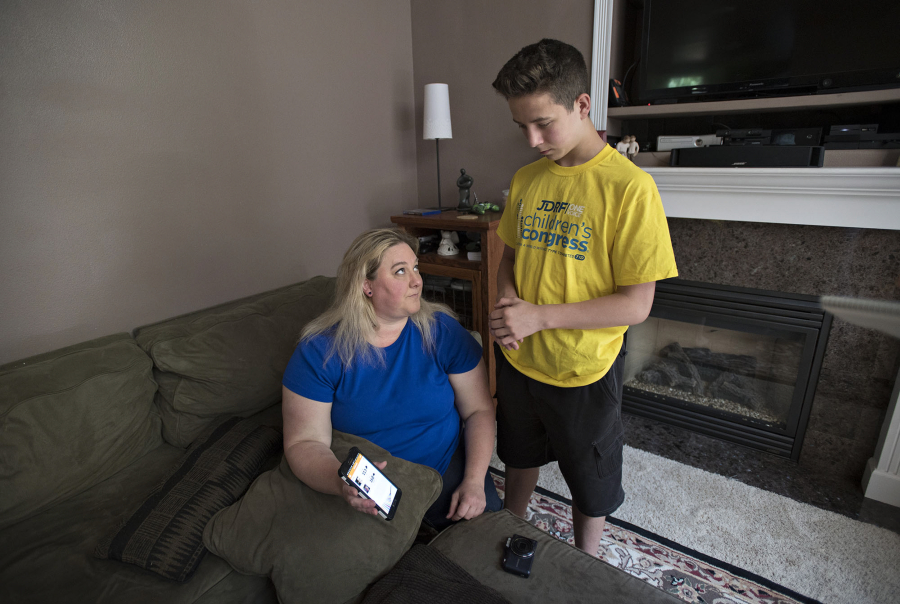Anthony Ross was just 3 1/2 years old when he was diagnosed with Type 1 diabetes. Before his fifth birthday, Anthony got an insulin pump to help manage the disease.
Still, the Vancouver family struggled to adapt to Anthony’s lifestyle.
“It was difficult,” said Anthony’s mom, Darsi Ross. “He was 3. He didn’t understand why he couldn’t have things.”
The diagnosis came with a learning curve for Ross and her husband, Mat. Ross didn’t know anything about Type 1 diabetes. While Anthony was hospitalized after the diagnosis, she learned about carbohydrate counting and insulin and about target blood-sugar levels and balancing carbs with insulin.
“It was totally different from what I perceived in my head,” she said. “People don’t know about Type 1 like they do Type 2.”
Type 1 diabetes occurs when the body’s immune system destroys the beta cells in the pancreas, making the body incapable of producing insulin. Unlike Type 2 diabetes, which is often tied to obesity and a sedentary lifestyle, Type 1 diabetes cannot be slowed or reversed.
JDRF
The lack of understanding about Type 1 diabetes is what spurred Ross — and, as he got older, Anthony — to get involved with JDRF, a global nonprofit organization funding Type 1 diabetes research.
The family has participated in local fundraising bike rides and galas. Anthony has served as an ambassador for local fundraisers, and he’s advocated for diabetes research in Washington. And next week, Anthony will take that advocacy to the other Washington.
Anthony, 15, was selected as one of 160 kids to attend the JDRF 2017 Children’s Congress in Washington, D.C. The three-day event is held every two years and brings youth to D.C. to raise awareness about Type 1 diabetes and advocate for research funding to Congressional leaders.
“This is the biggest event where people raise the most money — one of the biggest things to educate people,” Anthony said. “I’ve been doing all these small things, and all these small things lead up to this.”
In Washington, D.C., the kids will talk to members of Congress and participate in a town hall event.
They are expected to meet President Donald Trump.
“I’m really excited to talk to the Congress people,” Anthony said. “I’m really excited to meet with the president, and I’m really excited to have the experience.”
Myth busting
The one thing Anthony and his mom wish people knew about Type 1 diabetes is that it’s different than Type 2 diabetes.
“I’ve had several people make comments about, ‘Maybe you shouldn’t have given them so much sugar,'” Ross said. Anthony’s brother, 11-year-old Austin, was diagnosed with Type 1 diabetes a year ago.
“I don’t think people realize how life-threatening it is,” she added. People think the boys can just change their diets and be OK.
“It’s a disease where people don’t see it on the outside, and it’s a manageable disease,” Ross said. “But that’s a daily thing — monitoring.”
Since getting an insulin pump, Anthony has a lot more freedom. The pump is calibrated to Anthony’s needs and checks his blood-sugar levels every five minutes. He and his mom monitor his levels through an app on their cellphones.
Before eating, Anthony tallies up the amount of carbs in his meal or snack and puts that info into the pump. The pump then administers the appropriate amount of insulin. Anthony is then free to eat without needing to prick his finger for a test or poke himself with a needle full of insulin.
“That’s why we advocate,” Ross said. “It makes it easier for everyone living with it, without that stress.”
Anthony also has a diabetes alert dog — a 2-year-old black English Labrador named Gracie. Gracie can sense when Anthony’s blood-sugar levels are dropping and alert him — she pushes her nose on a dog bell at the house or paws at Anthony — before his monitor sounds off.
Having that early warning is particularly helpful because Anthony’s blood-sugar levels can drop significantly and quickly, particularly at night, Ross said. Gracie is also the one who alerted the family that Austin was diabetic,.
Anthony said his diabetes doesn’t interfere too much with his life — sometimes he has to sit out of karate or other activities because his blood-sugar levels are too low. But, Anthony said, he’s never known any different.
Still, he and his mom hope that some day the disease will have a cure so it doesn’t impact lives at all.
“I want the technology that’s helped me live to advance,” Anthony said. “I want to live a life where I don’t have to worry about diabetes.”




